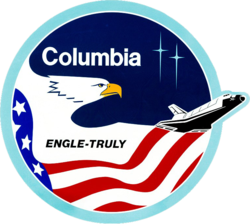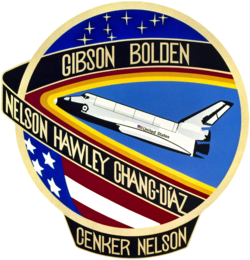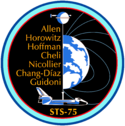Columbia (rymdfärja)
- För andra betydelser, se Columbia.
| Columbia OV-102 | |
 Rymdfärjan Columbia startar på STS-109(HST-3B) för att reparera rymdteleskopet Hubble. Detta var Columbias sista lyckade uppdrag före STS-107. | |
| OV-beteckning | OV-102 |
|---|---|
| Land | USA |
| Kontraktstilldelning | 26 juli 1972 |
| Namngiven efter | Columbia (1773) (omdöpt till Columbia Rediviva 1787) |
| Status | Brann upp 1 februari 2003 |
| Första flygning | STS-1 12 – 14 april 1981 |
| Sista flygning | STS-107 16 januari – 1 februari 2003 |
| Antal uppdrag | 28 |
| Besättningsmedlemmar | 160 |
| Tid i rymden | 300 dagar 17:40:22 |
| Antal genomförda omloppsvarv | 4 808 |
| Tillryggalagd sträcka | 201 497 772 km (125 204 911 miles) |
| Satelliter utplacerade | 8 |
Columbia (OV-102) var den första rymdfärja som togs i bruk av NASA. Första flygningen genomfördes mellan 12 och 14 april 1981. Den 1 februari 2003, vid slutet av sitt 28:e uppdrag, brann Columbia upp under återinträde i jordens atmosfär, och alla sju rymdfarare inuti omkom.[1]
Historik
Tillverkningen av Columbia påbörjades 27 mars 1975 och den 24 mars 1979 kom rymdfärjan till John F. Kennedy Space Center i Florida för att förberedas för sin första uppskjutning. Den 19 mars 1981 dödades två arbetare och fem skadades då man testade en av färjans funktioner.[2]
Med på Columbias första flygning fanns två astronauter, John W. Young som befälhavare, en veteran från Gemini- och Apolloprogrammen, och Robert Crippen, som aldrig tidigare varit i rymden, som pilot.
Columbia har rekordet för längsta färd i rymden bland alla rymdfärjor.
Columbias sista uppdrag
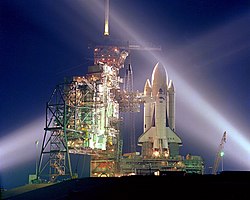

På Columbias sista uppdrag medföljde i besättningen Ilan Ramon, den första israeliske astronauten, och den första kvinnliga astronauten född i Indien, Kalpana Chawla. Med på det sista uppdraget fanns även Rick Husband (befälhavare), William McCool (pilot), Michael P. Anderson, Laurel Clark och David Brown.
Columbia lyfte den 16 januari 2003 och genomförde sitt uppdrag utan problem fram till återinträdet i jordatmosfären. På morgonen den 1 februari, efter 16 dagar i rymden, förlorade Nasa radiokontakten med färjan, endast en dryg kvart före den väntade landningen kl. 9.16 på John F. Kennedy Space Center i Florida. Videoinspelningar visar att Columbia förintades under återinträdet, på cirka 63 km höjd över Texas, då hon hade en hastighet på 5,6 km/s.
Det som ledde till katastrofen var att en bit av isoleringen på bränsletanken lossnade under uppskjutningen. Ingen tog någon notis om detta då det är vanligt förekommande. I det här fallet kom den lossnade isoleringsbiten att träffa och orsaka en skada på ena vingens isoleringsplattor vilket gjorde att det inom ett mindre område saknades skydd mot hettan som uppstår vid återinträde i atmosfären.
Efter olyckan började man att filma och undersöka rymdfärjorna efter uppskjutning. Detta gjordes av både besättning och markkontroll. Man började också ta med sig verktyg för enklare reparationer om man skulle upptäcka skador.
Rymdfärdsuppdragen

| Uppdragsemblem för Columbias flygningar | |||||||
|---|---|---|---|---|---|---|---|
 |  |  |  |  |  | ||
| STS-1 | STS-2 | STS-3 | STS-4 | STS-5 | STS-9 | STS-61-C | |
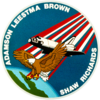 | 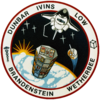 |  |  |  |  |  | |
| STS-28 | STS-32 | STS-35 | STS-40 | STS-50 | STS-52 | STS-55 | |
 |  |  |  |  |  |  | |
| STS-58 | STS-62 | STS-65 | STS-73 | STS-75 | STS-78 | STS-80 | |
 |  |  |  | 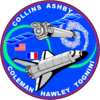 |  |  | |
| STS-83 | STS-94 | STS-87 | STS-90 | STS-93 | STS-109 | STS-107 | |
| Uppdragsemblem för planerade Columbia flygningar | |||||||
 |  | ||||||
| STS-118 (Uppdraget utfördes senare av Endeavour. Se STS-107) | STS-121 (Uppdraget utfördes senare av Discovery. Se STS-107) | ||||||
Källor
- Den här artikeln är helt eller delvis baserad på material från engelskspråkiga Wikipedia, tidigare version.
Fotnoter
- ^ Lennart Pehrson (1 februari 2003). ”Sju astronauter dog i rymdkatastrof”. Dagens nyheter. http://www.dn.se/nyheter/varlden/sju-astronauter-dog-i-rymdkatastrof/. Läst 18 februari 2017.
- ^ ”March 19, 1981: Shuttle 's First Fatalities” (på amerikansk engelska). Wired. ISSN 1059-1028. https://www.wired.com/2009/03/march-19-1981-shuttle-s-first-fatalities/. Läst 13 juli 2022.
Externa länkar
- NASA - Columbia (OV-102)
 Wikimedia Commons har media som rör Columbia (rymdfärja).
Wikimedia Commons har media som rör Columbia (rymdfärja).
| ||||||||
| |||||||||||
| |||||||||||||||||||||||||||||||||
Media som används på denna webbplats
STS-28 mission patch
- The STS-28 insignia was designed by the astronaut crew, who said it portrays the pride the American people have in their manned spaceflight program. It depicts America (the eagle) guiding the space program (the Space Shuttle) safely home from an orbital mission. The view looks south on Baja California and the west coast of the United States as the space travelers re-enter the atmosphere. The hypersonic contrails created by the eagle and Shuttle represent the American flag. The crew called the simple boldness of the design symbolic of America's unfaltering commitment to leadership in the exploration and development of space.
STS-5 mission insignia
This mission patch for mission STS-80 depicts the Space Shuttle Columbia and the two research satellites its crew deployed into the blue field of space. The uppermost satellite is the Orbiting Retrievable Far and Extreme Ultraviolet Spectrograph-Shuttle Pallet Satellite (ORFEUS-SPAS), a telescope aimed at unraveling the life cycles of stars and understanding the gases that drift between them. The lower satellite is the Wake Shield Facility (WSF), flying for the third time. It will use the vacuum of space to create advanced semiconductors for the nation's electronics industry. ORFEUS and WSF are joined by the symbol of the Astronaut Corps, representing the human contribution to scientific progress in space. The two bright blue stars represent the mission's Extravehicular Activities (EVA), final rehearsals for techniques and tools to be used in assembly of the International Space Station (ISS). Surrounding Columbia is a constellation of 16 stars, one for each day of the mission, representing the stellar talents of the ground and flight teams that share the goal of expanding knowledge through a permanent human presence in space.
This is the official insignia for STS-9, the major payload of which is Spacelab 1, depicted in the cargo bay of the Columbia. The nine stars and the path of the orbiter tell the flight's numerical designation in the Space Transportation System's mission sequence. Astronaut John N. Young is crew commander, Brewster N. Shaw, Jr., pilot. NASA Astronauts Owen K. Garriott and Robert A. Parker are mission specialists. Byron K. Lichtenberg of the Massachusetts Institute of Technology and Ulf Merbold of the Republic of West Germany are the Spacelab 1 payload specialists. Launch has been set for late 1983. Merbold is a physicist representing the European Space Agency (ESA).
The STS-87 patch is shaped like a space helmet symbolizing the Extravehicular Activity (EVA) on the mission in support of testing of tools for the assembly of the International Space Station (ISS). Earth is shown reflected on the backside of the helmet. The Space Shuttle Columbia forms the interface between the Earth and the heavens, the back and front sides of the helmet in profile. The three red lines emerging from Columbia represent the astronaut symbol as well as the robot arm, which was used to deploy and retrieve the Spartan satellite.
The text 'µg' represents the payloads studying microgravity science in space on this United States Microgravity Payload (USMP-4) mission. Gold flames outlining the helmet visor represent the corona of the Sun, which will be studied by Spartan. The flag of Ukraine is next to the name of the payload specialist who is the first person from that nation to fly on the Space Shuttle.
The STS-118 patch represents Space Shuttle Endeavour on its mission to help complete the assembly of the International Space Station (ISS), and symbolizes the pursuit of knowledge through space exploration. The flight will accomplish its ISS 13A.1 assembly tasks through a series of spacewalks, robotic operations, logistics transfers, and the exchange of one of the three long-duration expedition crew members. On the patch, the top of the gold astronaut symbol overlays the starboard S-5 truss segment, highlighting its installation during the mission. The flame of knowledge represents the importance of education, and honors teachers and students everywhere. The seven white stars and the red maple leaf signify the American and Canadian crew members, respectively, flying aboard Endeavour.
The STS-78 patch links past with present to tell the story of its mission and science through a design imbued with the strength and vitality of the 2-dimensional art of North America's northwest coast Indians. Central to the design is the space Shuttle whose bold lines and curves evoke the Indian image for the eagle, a native American symbol of power and prestige as well as the national symbol of the United States. The wings of the Shuttle suggest the wings of the eagle whose feathers, indicative of peace and friendship in Indian tradition, are captured by the U forms, a characteristic feature of Northwest coast Indian art. The nose of the Shuttle is the strong downward curve of the eagle's beak, and the Shuttle's forward windows, the eagle's eyes, represented through the tapered S forms again typical of this Indian art form.
The basic black and red atoms orbiting the mission number recall the original NASA emblem while beneath, utilizing Indian ovoid forms, the major mission scientific experiment package LMS (Life and Materials Sciences) housed in the Shuttle's cargo bay is depicted in a manner reminiscent of totem-pole art. This image of a bird poised for flight, so common to Indian art, is counterpointed by an equally familiar Tsimshian Indian symbol, a pulsating sun with long hyperbolic rays, the symbol of life. Within each of these rays are now encased crystals, the products of this mission's 3 major, high-temperature materials processing furnaces. And as the sky in Indian lore is a lovely open country, home of the Sun Chief and accessible to travelers through a hole in the western horizon, so too, space is a vast and beckoning landscape for explorers launched beyond the horizon.
Beneath the Tsimshian sun, the colors of the earth limb are appropriately enclosed by a red border representing life to the Northwest coast Indians. The Indian colors of red, navy blue, white, and black pervade the STS-78 path. To the right of the Shuttle-eagle, the constellation Delphinus recalls the dolphin, friend of ancient sailors and, now perhaps too, of the 9 space voyagers suggested by this constellation's blaze of 9 stars. The patch simultaneously celebrates international unity fostered by the Olympic spirit of sports competition at the 1996 Olympic Games in Atlanta, Georgia, U.S.A. Deliberately poised over the city of Atlanta, the Space Shuttle glows at its base with the 5 official Olympic rings in the 5 Olympic colors which can also be found throughout the patch, rings and colors which signify the 5 continents of the earth. This is an international mission and for the first time in NASA patch history, astronauts have dispensed with identifying country flags beneath their names to celebrate the spirit of international unity so characteristic of this flight.STS-94 insignia
STS-4 Mission patch
The crew patch of STS-73, the second flight of the United States Microgravity Laboratory (USML-2), depicts the Space Shuttle Columbia in the vastness of space. In the foreground are the classic regular polyhedrons that were investigated by Plato and later Euclid. The Pythagoreans were also fascinated by the symmetrical three-dimensional objects whose sides are the same regular polygon. The tetrahedron, the cube, the octahedron, and the icosahedron were each associated with the Natural Elements of that time: fire (on this mission represented as combustion science); Earth (crystallography), air and water (fluid physics). An additional icon shown as the infinity symbol was added to further convey the discipline of fluid mechanics. The shape of the emblem represents a fifth polyhedron, a dodecahedron, which the Pythagoreans thought corresponded to a fifth element that represented the cosmos.
STS-62 Mission Insignia
STS-32 Mission Insignia
- The STS-32 patch, designed by the five crewmembers for the January, 1990 space mission, depicts the Space Shuttle orbiter rendezvousing with the Long Duration Exposure Facility (LDEF) satellite from above and the Syncom satellite successfully deployed and on its way to geosynchronous orbit. Five stars represent the mission number with three on one side of the orbiter and two on the other. The seven major rays of the sun are in remembrance of the crewmembers for STS 51-L. In preparation for the first Extended Duration Orbiter (EDO) missions, STS-32 conducted a number of medical and middeck scientific experiments. The caduceus on the left represents the medical experiments, and the crystalline structure on the right represents the materials science. The crew is comprised of Astronauts Daniel C. Brandenstein, James D. Wetherbee, Bonnie Dunbar, Marsha S. Ivins, and G. David Low.
STS-52 Columbia, Orbiter Vehicle (OV) 102, crew insignia (logo), the Official insignia of the NASA STS-52 mission, features a large gold star to symbolize the crew's mission on the frontiers of space. A gold star is often used to symbolize the frontier period of the American West. The red star in the shape of the Greek letter lambda represents both the laser measurements to be taken from the Laser Geodynamic Satellite (LAGEOS II) and the Lambda Point Experiment, which is part of the United States Microgravity Payload (USMP-1). The LAGEOS II is a joint Italian \ United States (U.S.) satellite project intended to further our understanding of global plate tectonics. The USMP-1 is a microgravity facility which has French and U.S. experiments designed to test the theory of cooperative phase transitions and to study the solid\liquid interface of a metallic alloy in the low gravity environment. The remote manipulator system (RMS) arm and maple leaf are emblematic of the Canadian payload specialist Steven MacLean.
Emblem of Nasa's STS-109 mission.
STS-55 Mission Insignia
Logo of Sts-3 mission
STS-65 Mission Insignia
STS-40 Mission Insignia
Författare/Upphovsman: Pascal (Flickr user: pasukaru76), Licens: CC0
Vostok spacecraft replica at the Technik Museum Speyer, Germany.
Mission patch for STS-2 Space Shuttle mission
STS-35 Mission Insignia
A close-up camera view shows Space Shuttle Columbia as it lifts off from Launch Pad 39A on mission STS-107. Launch occurred on schedule on 16th of January, 2003 at 10:39 EST (15:39 UTC).
Spaceship Columbia launch at dawn
- Caption: "KSC-02PD-0217 (03/01/2002) --- KENNEDY SPACE CENTER, FLA. -- Space Shuttle Columbia emblazons the pre-dawn clouds as it soars into the sky on its 27th flight into space on STS-109. Liftoff occurred at 5:22:02:08 a.m. CST(11:22:02:08 GMT). The goal of the mission is the maintenance and upgrade of the Hubble Space Telescope, to be carried out in five spacewalks."
STS-61-c mission patch
- Columbia, which opened the era of the Space Transportation System with four orbital flight tests, is featured in re-entry in the emblem designed by the STS-61C crew representing the seven team members who manned the vehicle for its seventh STS mission. Gold lettering against black background honors the astronaut crewmembers on the delta pattern surrounding colorful re-entry shock waves, and the payload specialists are honored similarly below the sphere.
The crew patch for NASA's STS-83 mission depicts the Space Shuttle Columbia launching into space for the first Microgravity Sciences Laboratory 1 (MSL-1) mission. MSL-1 investigated materials science, fluid dynamics, biotechnology, and combustion science in the microgravity environment of space, experiments that were conducted in the Spacelab Module in the Space Shuttle Columbia's cargo bay. The center circle symbolizes a free liquid under microgravity conditions representing various fluid and materials science experiments. Symbolic of the combustion experiments is the surrounding starburst of a blue flame burning in space. The 3-lobed shape of the outermost starburst ring traces the dot pattern of a transmission Laue photograph typical of biotechnology experiments. The numerical designation for the mission is shown at bottom center. As a forerunner to missions involving International Space Station (ISS), STS-83 represented the hope that scientific results and knowledge gained during the flight will be applied to solving problems on Earth for the benefit and advancement of humankind.
Carrying the STS-109 crew of seven, the Space Shuttle Orbiter Columbia blasted from its launch pad as it began its 27th flight and 108th flight overall in NASA's Space Shuttle Program. Launched March 1, 2002, the goal of the mission was the maintenance and upgrade of the Hubble Space Telescope (HST) which was developed, designed, and constructed by the Marshall Space Flight Center. Captured and secured on a work stand in Columbia's payload bay using Columbia's robotic arm, the HST received the following upgrades: replacement of the solar array panels; replacement of the power control unit (PCU); replacement of the Faint Object Camera (FOC) with a new advanced camera for Surveys (ACS); and installation of the experimental cooling system for the Hubble's Near-Infrared Camera and Multi-object Spectrometer (NICMOS), which had been dormant since January 1999 when it original coolant ran out. Four of the crewmembers performed 5 space walks in the 10 days, 22 hours, and 11 minutes of the the STS-109 mission.
STS-58 Crew Insignia
Columbia väntar på att skjutas upp för första gången, den 12 april 1981
The STS-121 patch depicts the Space Shuttle docked with the International Space Station (ISS) in the foreground, overlaying the astronaut symbol with three gold columns and a gold star. The ISS is shown in the configuration that it will be in during the STS-121 mission. The background shows the nighttime Earth with a dawn breaking over the horizon. STS-121, ISS mission ULF1.1, is the final Shuttle Return to Flight test mission. This utilization and logistics flight will bring a multipurpose logistics module (MPLM) to the ISS with several thousand pounds of new supplies and experiments. In addition, some new orbital replacement units (ORUs) will be delivered and stowed externally on ISS on a special pallet. These ORUs are spares for critical machinery located on the outside of the ISS. During this mission the crew will also carry out testing of Shuttle inspection and repair hardware, as well as evaluate operational techniques and concepts for conducting on-orbit inspection and repair.
STS-90 insignia
- The STS-90 crew patch reflects the dedication of the mission to neuroscience in celebration of the decade of the brain. Earth is revealed through a neuron-shaped window, which symbolizes new perspectives in the understanding of nervous system development, structure and function, both here on Earth and in the microgravity environment of space.
- The Space Shuttle Columbia is depicted with its open payload bay doors revealing the Spacelab within. An integral component of the mission, the laboratory/science module provided by the European Space Agency (ESA), signifies the strong international involvement in the mission. The seven crew members and two alternate payload specialists, Chiaki Naito-Mukai and Alexander W. Dunlap, are represented by the nine major stars of the constellation Cetus (the whale) in recognition of the International Year of the Ocean.
- The distant stars illustrate the far reaching implications of the mission science to the many sponsoring agencies, helping prepare for long-duration space flight aboard the International Space Station (ISS).
- The moon and Mars are depicted to reflect the crew's recognition that those two celestial bodies will be the next great challenges in human exploration of space and represent the key role that life science research will play in supporting such missions.
The crew patch of STS-50, United States Microgravity Laboratory-One (USML-1), captures a Space Shuttle traveling above Earth while trailing the USML banner. The Orbiter is oriented vertically in a typical attitude for microgravity science and in this position represents the numeral 1 in the mission's abbreviated title. This will be the first in a series of USML flights where the primary objective is microgravity science, planned and executed through the combined efforts of our country's government, industry, and academia.
Visible in the orbiter's payload bay are the Spacelab module, and the extended duration Orbiter "cryo" pallet which is being flown for the first time on STS-50. The small g and Greek letter mu on the Spacelab module symbolize the microgravity environment being used for research in the areas of materials science and fluid physics. The large block letter U extends outside of the patch's perimeter, symbolizing the potential for the experiments on this flight to expand the current boundaries of knowledge in microgravity science.
The Stars and Stripes of the USML block letter and the U.S. landmass visible in the Earth scene below the Orbiter reflect the crew's pride in the United States origin of all on-board experiments.STS093 (S)-001 (Sept. 1998) --- The STS-93 mission patch, as designed by the five crew members. The STS-93 mission will carry the Advanced X-ray Astrophysics Facility (AXAF) into low Earth orbit initiating its planned five-year astronomy mission. AXAF is the third of NASA's great observatories, following the Hubble Space Telescope and the Compton Gamma Ray Observatory. AXAF will provide scientists an order-of-magnitude improvement over current capabilities at X-ray wavelengths. Observations of X-ray emissions from energetic galaxies and clusters, as well as black holes, promise to greatly expand current understanding of the origin and evolution of our universe. The STS-93 patch depicts AXAF separating from the Space Shuttle Columbia after a successful deployment. A spiral galaxy is shown in the background as a possible target for AXAF observations. The two flags represent the international crew, consisting of astronauts from both the United States and France. The NASA insignia design for Shuttle flights is reserved for use by the astronauts and for other official use as the NASA Administrator may authorize. Public availability has been approved only in the form of illustrations by the various news media. When and if there is any change in this policy, which we do not anticipate, it will be publicly announced.
STS-1 CREW PATCH
This is the official insignia for the first Space Shuttle orbital flight test (STS-1). Crew of the 102 Columbia on STS-1 was Astronauts John W. Young, commander, and Robert Crippen, pilot. The art work was done by artist Robert McCall.
STS-75 Mission Insignia
STS107-S-001 (May 2001) This is the insignia for w:STS-107, which is a multi-discipline microgravity and Earth science research mission with a multitude of international scientific investigations conducted continuously during the planned 16 days on orbit. The central element of the patch is the microgravity symbol, µg, flowing into the rays of the astronaut symbol. The mission inclination is portrayed by the 39 degree angle of the astronaut symbol to the Earth's horizon. The sunrise is representative of the numerous experiments that are the dawn of a new era for continued microgravity research on the International Space Station and beyond. The breadth of science conducted on this mission will have widespread benefits to life on Earth and our continued exploration of space illustrated by the Earth and stars. The constellation Columba (the dove) was chosen to symbolize peace on Earth and the Space Shuttle Columbia. The seven stars also represent the mission crew members and honor the original astronauts who paved the way to make research in space possible. The Israeli flag is adjacent to the name of the payload specialist who is the first person from that country to fly on the Space Shuttle.





















